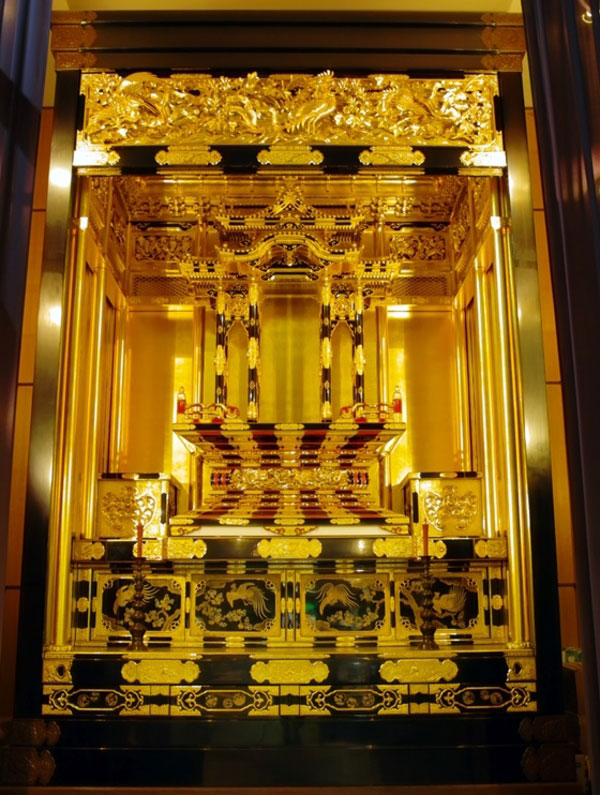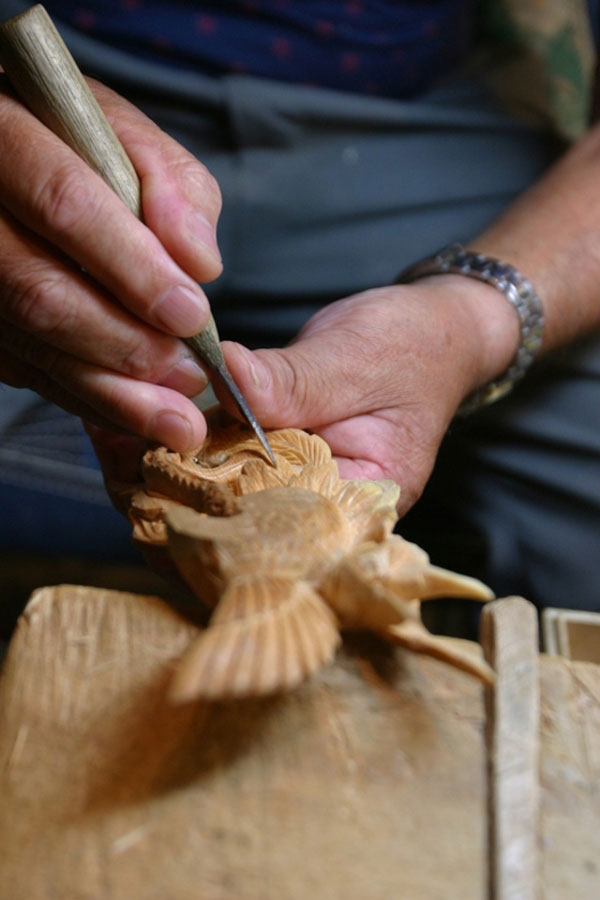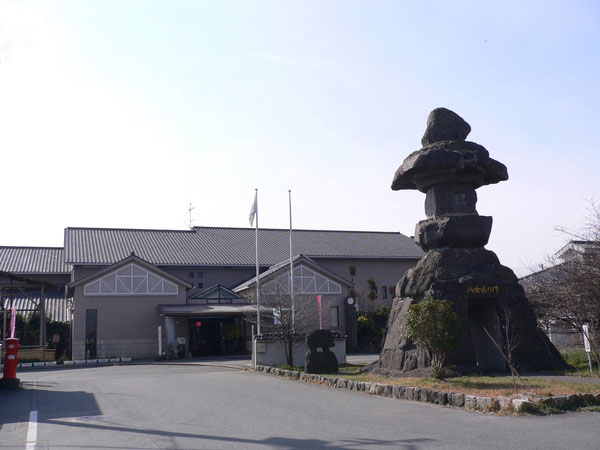 Photo:Fukuoka City
Photo:Fukuoka City
- Household Buddhist altars
- Fukuoka
Yame-fukushima Buddhist altar Yame fukushima butsudan
Magnificence and splendor
Expertise handed down for generations
Description
What is Yame-fukushima Buddhist altar ?
Yame Fukushima Butsudan are Buddhist altars made in Yame City (former Fukushima Town), Fukushima Prefecture. Dotted with many temples, the Yame region had been a place where there were many devout Buddhists since ancient times, which supported the development of altar production. Yame Fukushima Butsudan is characterized by its unique style copying the multi-storied Buddhist sanctum with luxurious and splendid decors. They have not been influenced by other Buddhist production areas and have their own individuality with gold leaves layered on the overall Urushi-painted surface. Yame Fukushima Butsudan is mostly handcrafted to maintain its magnificence and quality based on the tradition passed down from the Edo Period (1603 - 1868), and is also believed to be the origin of altar production in Kyushu. Household Buddhist altars are built lower to suit the design of an altar room equipped with a cabinet. With their original production techniques and outstanding quality, Yame Fukushima Butsudan has been of influence on other altar production areas nationwide. It is classified under three groups according to the shapes of the architrave: Fukushima style, Yame style, and Yahime style. The production process is divided, and expert artisans each work on their specialized task. It takes at least ten years of experience for an artisan to acquire necessary techniques and expertise.
History

History of Yame Fukushima Butsudan goes back to the mid-Edo Period. There is a story that is thought to be the beginning of Yame Fukushima Butsudan, where a cabinet maker saw a dream about a majestic, luxurious temple, and inspired by his dream, asked his workmates to help build a Buddhist altar. The Yame region of Fukushima Prefecture is the home of historical temples, including Daienji Temple built in the Nara Period (710 - 794) and Komyoji Temple founded by Buddhist monk Gyoki. Buddhist altar production began in this area with a background of strong religious devotion when prohibition against Christianity was imposed by the Tokugawa Shogunate. In the mid-19th century, when the techniques were established, Yame Fukushima Butsudan went into full-scale production and became the cradle of altar production in Kyushu. By the end of the Edo Period, Yame Fukushima altar production had been expanded while employing craftsmen in the respective processes, and it continued steady growth after the Meiji Restoration. Restrictions on livelihood and housing imposed by the Kurume clan were abolished due to the Meiji Restoration, allowing altar production to be recognized as an industry. As lifestyle changes with a trend toward nuclear families and a declining birthrate, Yame Fukushima Butsudan has been striving to send out information of their traditional techniques and the role of Buddhist altars in the family.
General Production Process
 Photo:Fukuoka City
Photo:Fukuoka City
- 1. Wooden base Yame Fukushima Butsudan undergoes more than 80 processes, where each process is professionally handcrafted by expert craftsmen, except for some steps in the wooden base, inner sanctuary and wood sculpture process. It takes more than ten years to acquire the necessary techniques. Cedar, Japanese cypress or Japanese big-leaf magnolia is carefully selected for the base of the altar. Wood is cut to the predetermined sizes for the main frame. The base is classified under three groups according to the structure: Fukushima style (triple-layer architrave), Yame style (cabinet-type architrave), and Yahime style (double-layer architrave with a drawer). The upper section above the base is assembled to make dismantling easy.
- 2. Inner sanctuary The inner wooden sanctuary is comprised of a roof and peripheral parts, which is located inside the altar. The inner sanctuary is modeled after a sect-designated temple, with a roof designed like that of Higashi and Nishi Hongan-ji Temples. A sanctuary is said to be designed in the artisan’s head, which requires proficient skills. The handcrafted elaborate parts are assembled in sequence.
- 3. Wood sculpture There are carving techniques called maru-bori, tsuke-bori and kasane-bori. Maru-bori is drawing a sect-designated design and carving it from a solid block of wood. Tsuke-bori is coarse carving while considering the design. Kasane-bori is carving multiple layers of three boards to give depth and a three-dimensional appearance. Japanese cypress wood or Korean pine wood is used, and different kinds of chisels and knives are used for decor carving.
- 4. Ornamental fine metal The ornamental fine metal used for Yame Fukushima Butsudan are all handcrafted. Copper, copper alloy or base metal sheet are engraved and are finished with a plating of fine gold. The engraving techniques include hairline engraving for planar patterns and engraving for embossed patterns to give a three-dimensional appearance.
- 5. Urushi lacquering First, a mixture of polishing powder and animal glue is applied to the shaped wooden base as a ground coating. This is to reinforce the wood base and prevent it from absorbing the urushi lacquer. The base is dried and polished carefully with charcoal, and refined natural urushi lacquer is painted onto the surface. The lacquered piece is then placed in a room called urushi muro which is used for drying and curing while protecting the piece from dust.
- 6. Gilding After the lacquering process, a special lacquer for gilding is applied over the urushi-painted surface and is wiped with a cotton cloth. Then, using special bamboo tweezers, gold leaf layers are gently placed over the surface one by one. Ornamental fine metal requires baking with charcoal fire after the gold leaf layers are placed to bake the gold leaf on the metal ornament for protection. As any dust during the gilding process must be avoided, this process requires meticulous work.
- 7. Maki-e Maki-e is a traditional technique of drawing exquisite patterns or designs that cannot be expressed with metal ornaments or carvings. Painted with urushi lacquer, the base is dried for 3 to 5 hours. Then, the urushi-painted surface is sprinkled with gold or silver powder, or naturally shiny shells to deliver an exquisite finish. As the gold powder is sprinkled within 2 to 3 minutes, this process requires much experience as well as concentration.
- 8. Assembly Assembly is the final process of Yame Fukushima Butsudan. This is conducted by an artisan with much experience and expertise, as the artisan must handle all of the altar parts. All the parts are gathered in a place and assembled to complete one altar by tenoning the bases of the inside and outside of the altar and inlaying the inner parts.
Where to Buy & More Information
Yame Dento Kogeikan

-
Address
-
Tel.+81-94-322-3131
-
ClosedMondays , around the New Year
-
Business Hours9am to 5pm
-
Website
See more Household Buddhist altars
- Osaka Buddhist altar
- Hikone Buddhist altar
- Iiyama Buddhist altar
- Nagoya Buddhist altar
- Kanazawa Buddhist altar
- Kawanabe Buddhist altar
- Kyo Buddhist altar
- Hiroshima Buddhist altar
- Mikawa Buddhist altar
- Kyo Buddhist altar equipment
- Nanao Buddhist altar
- Yamagata Buddhist altar
- Yame-fukushima Buddhist altar
- Nagaoka Buddhist altar
- Sanjo Buddhist altar
- Niigata-shirone Buddhist altar
- Owari Buddhist altar equipment































































































































































































































































































